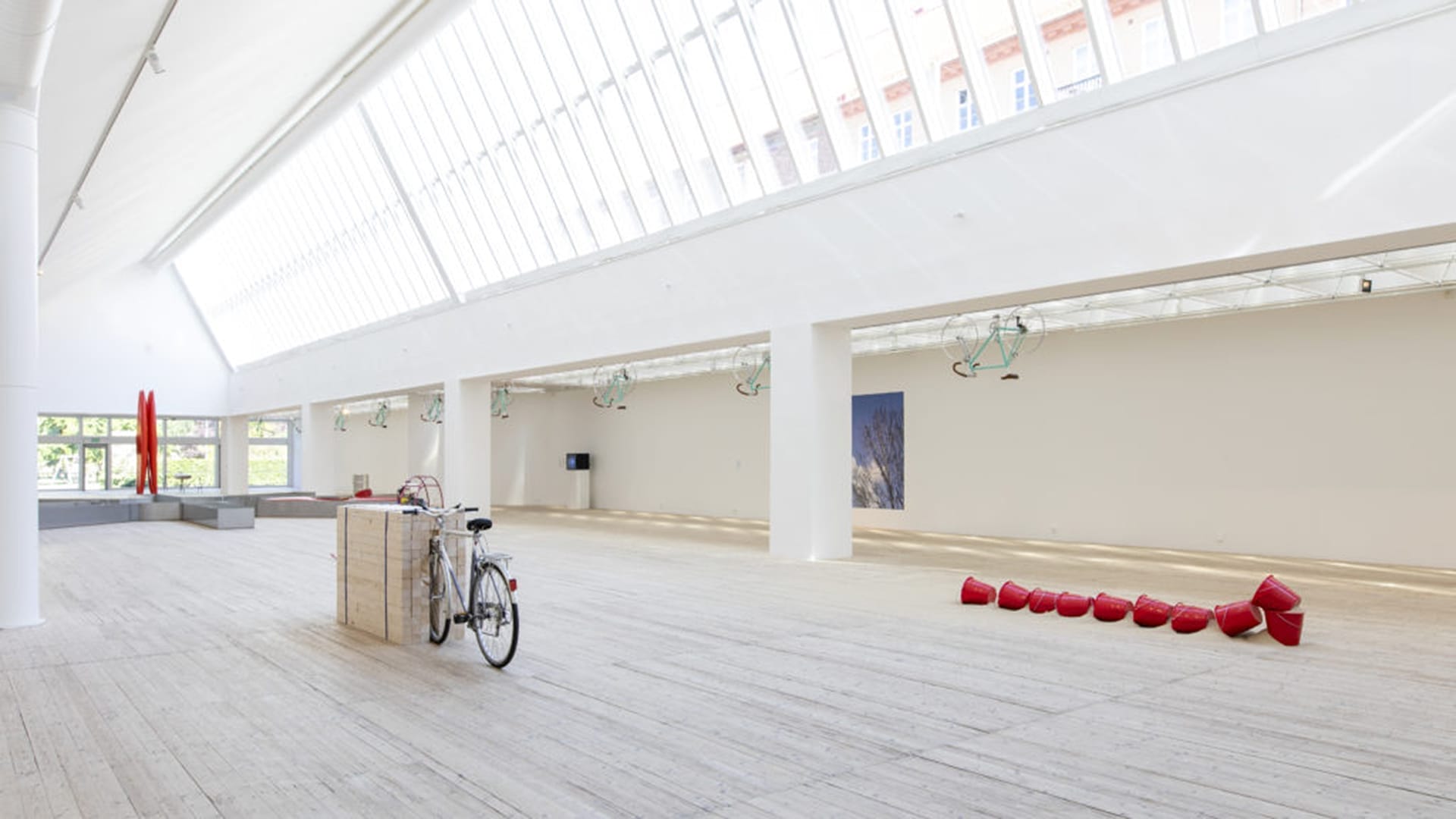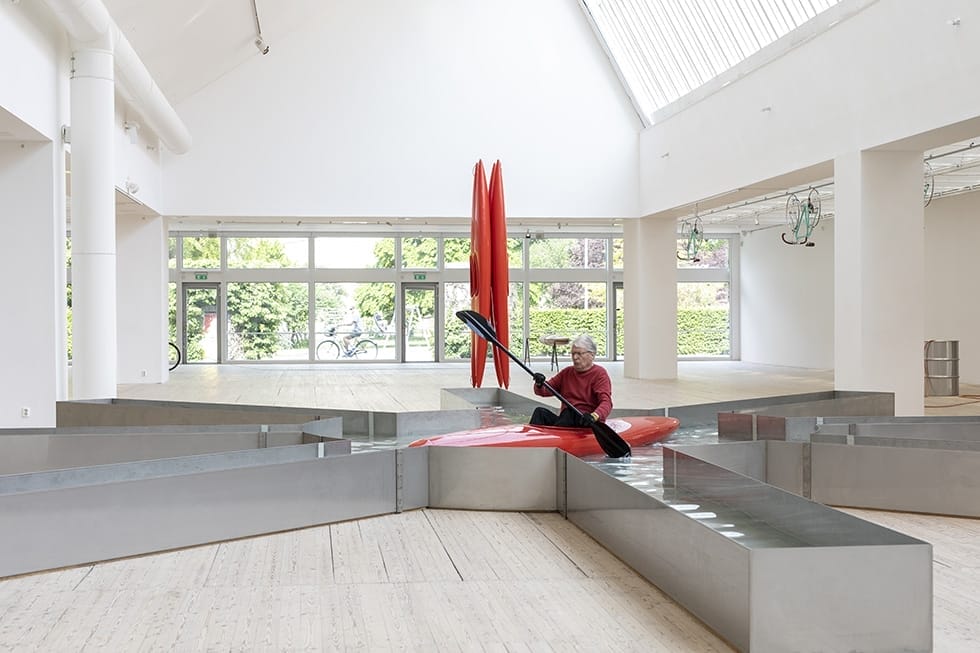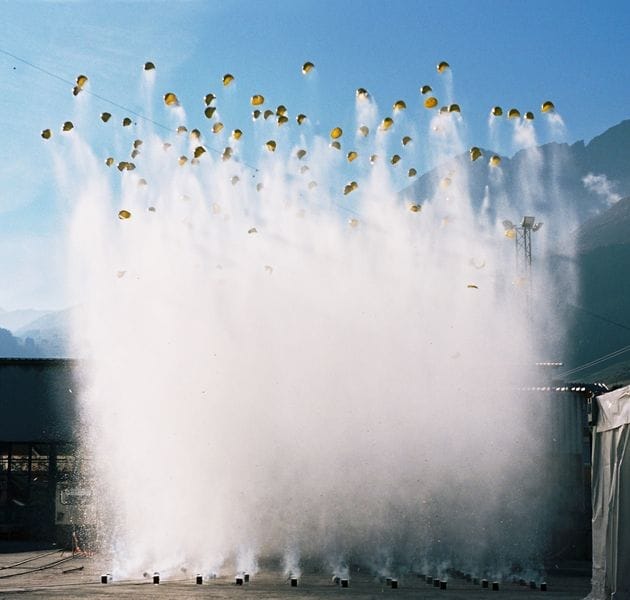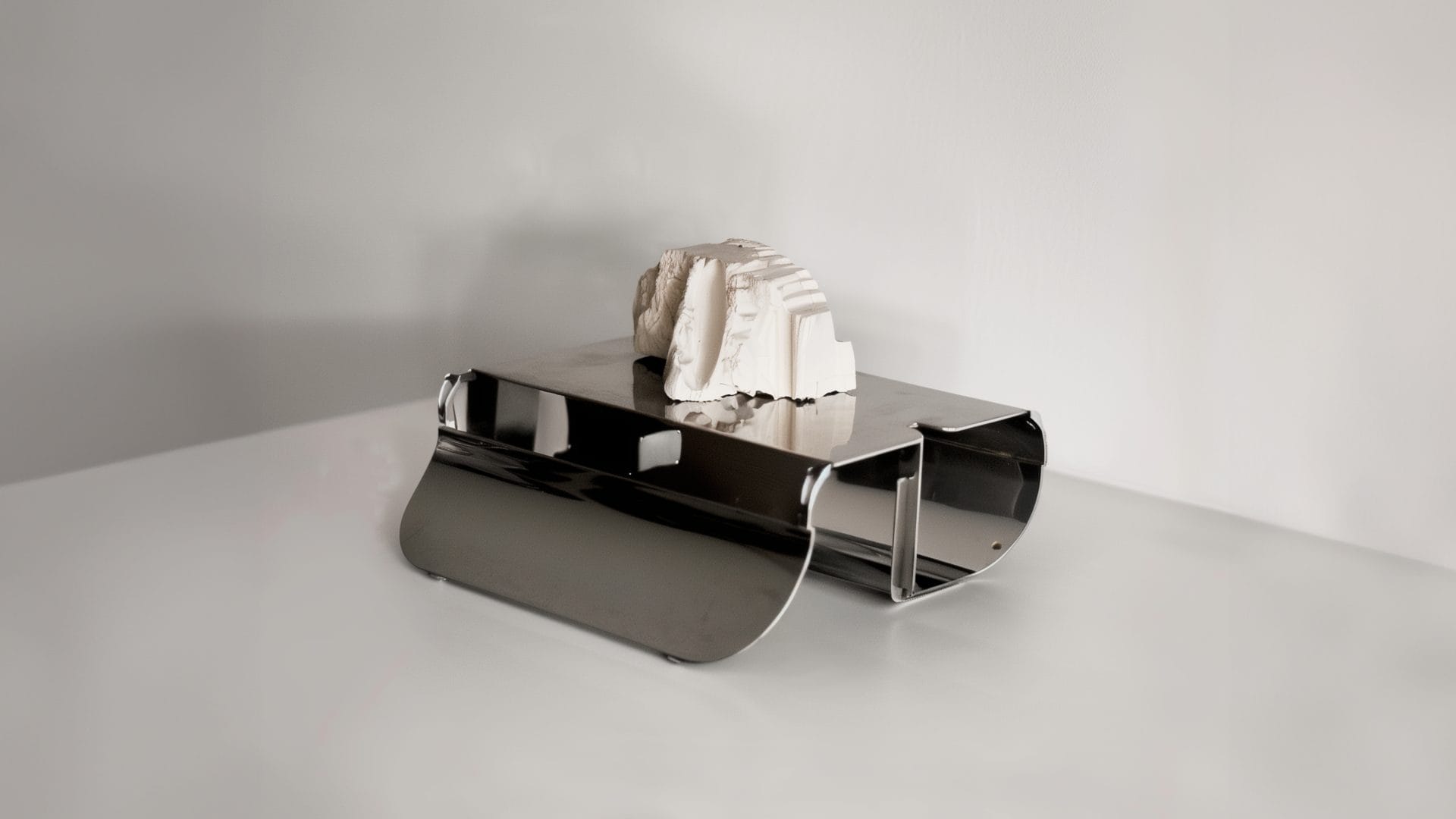
Roman Signer: Ingenious Humor and Startling Tension
Roman Signer, an artist whose career spans over fifty years, has reinvented the concept of sculpture by working with time-based processes and materials. His work, deeply rooted in the physics of cause and effect, reflects a continuous experiment with reality itself. Signer challenges traditional scientific logic through an artistic approach, thereby creating a synergy between the natural world and human interpretation.
Signer’s workshop, where his “Zeitskulpturen” (temporal sculptures) come to life, is an arena where time, motion, and gravity converge. These often ephemeral pieces last only a few seconds but capture the metamorphosis of matter under the influence of natural laws and motive forces. Here, classical elements such as fire, wind, and water intertwine with everyday objects—umbrellas, kayaks, tables, boots, barrels—in brief and intense processes.
In this context, time is not just a measure but an essential factor that shapes and defines form. Signer’s sculpture unfolds not as a static object but as an event, a phenomenon that invites viewers to reflect on the transience and perpetual mutation of reality. How can time, often perceived as a linear constant, become an artistic medium manifesting in such diverse and unexpected forms?
The intrinsic dynamism in Signer’s works raises fundamental questions about the artist’s role in manipulating and reconfiguring time. Art, in this realm, becomes a dialogue between the inevitable progression of time and human intent. Signer, acting as a modern alchemist, transforms simple elements into complex experiences, where the fleeting moment becomes eternal in the viewer’s memory.
Thus, Signer’s temporal sculptures can be seen not just as artistic objects, but as philosophical explorations of time itself. How do we interpret the brevity, fragility, and intangibility of these moments? How does their visual and emotional impact persist beyond their physical dissolution? These questions, posed by Signer’s works, demand active reflection and immersion in the realm of abstract thought, where the perception of reality and the illusion of time meet and merge.

The Creative Gesture between Witty Humor and Startling Tension
The second area of exploration in Roman Signer’s work focuses on the bold and often humorous use of everyday objects. Tension and surprise are key elements in his artistic approach, where objects are subjected to various processes – pyrotechnics, kinetic energy, and aerodynamics. In this theater of action, Signer transforms the ordinary into the extraordinary, using the object as a medium to explore unforeseen interactions and latent potentials.
Signer’s ingenious humor does not stem from superficial comedy, but rather from his ability to subvert expectations and unveil new perspectives on familiar objects and phenomena. For instance, a kayak or an umbrella, in a normal context, have predictable functions. However, in Signer’s hands, these objects become protagonists in a narrative that defies conventional logic. What happens when an umbrella is subjected to the force of an explosion, or a kayak navigates in an unexpected setting?
This playful and experimental aspect of Signer’s work opens a window onto the dialogue between order and chaos. The artist orchestrates moments of calm and sudden bursts of energy, creating a tension field where the viewer’s expectation is continuously challenged. How does our sense of order and predictability relate to the surprising and unpredictable encounters in Signer’s art? And how do these experiences transform our perception of everyday objects and events?
In this process, the object becomes a kind of catalyst, not just for a physical reaction, but also for intellectual and emotional reflection. Signer’s work is thus not merely a demonstration of physical forces, but rather an invitation to reconsider our relationship with the material world and our expectations. In this sense, his art is a journey into the depths of the human experience, where simplicity clashes with complexity and the familiar becomes surprisingly new.
Signer’s skill in manipulating the commonplace to reveal the unusual raises essential questions: How can we derive meaning from the transformations of objects? In what ways does the interaction between natural forces and human-made artifacts lead us to new understandings of the environment that surrounds us? The answer to these questions, implicit in Signer’s work, requires a keen eye and an open mind, ready to embrace the wonders hidden in the folds of the ordinary.

Signer’s First Solo Exhibition in Sweden: A Stage for Environmental Interactions
In his first major solo exhibition in Sweden at Malmö Konsthall, Roman Signer offers an overview of his artistic journey, spanning from the 1970s to the present. The Malmö Konsthall environment transforms into a stage where Signer’s works engage not only with the exhibition space but also with the external context of Pildammsparken. This choice is deliberate: the relationship between the works and their environment reveals a fundamental aspect of Signer’s work, namely the interaction with atmospheric conditions and water properties.
In this setting, Signer’s work extends beyond the traditional boundaries of the exhibition space. His outdoor installations are subject to variations and transformations dictated by natural forces. How do these conditions affect the perception of the works? What is the impact of nature’s unpredictability on Signer’s static installations? Wind, rain, and light changes turn the work into a living, changing entity, challenging the traditional notion of sculpture as something fixed and immutable.
Inside the Konsthall, Signer’s works take on a different dimension. The gallery becomes a place where controlled chaos and scientific precision meet. The installations, featuring objects like floating tables and kayaks, are arranged in a way that appears simple and functional, yet a closer examination reveals traces of soot and other signs of Signer’s pyrotechnic actions. This duality between apparent simplicity and underlying complexity invites the viewer to deeper observation. How does our perception of these everyday objects change when placed in an artistic context and subjected to physical transformations?
The exhibition does not only present physical works but also includes an extensive collection of filmed documentation of Signer’s sculptural processes. These films are crucial for fully understanding Signer’s work, as many of his temporal sculptures now exist only as recordings of their brief existences. The relationship between these recordings and the physical works raises questions about the nature of permanence in art and memory as a vehicle for artistic preservation. How do the direct experience of a temporal work and its documentation compare? How do memory and recording affect our understanding of art and its ability to endure over time?
In conclusion, Signer’s exhibition at Malmö Konsthall is an invitation to explore the relationship between art, time, memory, and environment. Each piece, both inside and outside the gallery, offers a unique reflection on these themes, prompting deep contemplation on the nature of art and its capacity to interact with the world around us. Through his art, Signer challenges us to reconsider our relationship with the environment and time itself, opening new perspectives on the perception and interpretation of the artistic world.

fakewhale
Founded in 2021, Fakewhale advocates the digital art market's evolution. Viewing NFT technology as a container for art, and leveraging the expansive scope of digital culture, Fakewhale strives to shape a new ecosystem in which art and technology become the starting point, rather than the final destination.
You may also like
Fakewhale Studio: Generative Constructions
Building is an act that goes far beyond the mere assembly of parts. Derived from the Latin “constr
Fakewhale Physical I: The Fakewhale Vault Permanent Collection
At its foundation, the Fakewhale Vault is an innovative curatorial project that aligns the tradition
“Rushes” at Fluentum, Berlin: video art that breathes through the ruins of the real
What’s left of lived experience when it’s constantly filtered, fragmented, and reframed through




